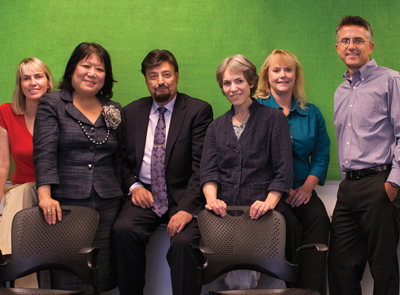San Jose State University
|
Project: SJSU Plus
Project lead: Ellen Junn, provost
Tech vendors/partners:
|
Massive open online courses have been both hailed and lamented as a disruptive force in higher education. At a time when many universities are still trying to determine where they fit in the MOOC landscape, San Jose State University (CA) had the vision to become the first university to combine MOOC content with college credit.
Starting about a year ago, under the guidance of project lead and provost Ellen Junn, SJSU began exploring MOOCs as a means to alleviate bottlenecks in high-demand remedial and gateway courses, as well as to improve the outcomes of courses with high failure rates. The university partnered with edX to pilot materials from edX 6.002x, an MIT course on circuits and electronics, in SJSU's own Introduction to Circuit Analysis course. In a flipped model, students were assigned the edX video and quiz content as homework, with class time used for teamwork and problem solving. Students were charged the standard state fee for enrolling in the course.

SJSU's MOOC Innovators |
SJSU also initiated a partnership with MOOC provider Udacity to offer three credit-bearing online courses: Remedial Math, College Algebra, and Elementary Statistics. Each Udacity course has 100 paying students (led by an SJSU instructor) and about 4,000 non-paying and separate students who learn on their own. As the enrollment rates expand, the class sizes can be easily scaled upward, allowing the university to keep up with course demand while boosting student engagement and success.
The MOOC content is based on active learning concepts, with students viewing short sequential videos interspersed with quiz questions. Knowledge is built in small steps until complex, difficult material is learned. SJSU administrators report that the format is personal and engaging, with up-close tutorials and real-life problem solving to compel students' attention.
The administrative and course management systems on campus adapted to the new scenario: PeopleSoft, the student information system, continued to function as usual for registration. The CASHNet eMarket system from Higher One allowed student payments to be processed quickly. And faculty continued to have access to Instructure's Canvas, the campuswide LMS, for grading and communications.
The piloting of MOOCs for credit on the SJSU campus is generally bringing observable, positive results. Catheryn Cheal, associate vice president and senior academic technology officer, comments: "Investing in carefully creating an intensely engaging MOOC with increased human mentoring may make it possible to scale the classroom to much larger numbers of students without reducing the quality of the individual student learning experience and without overburdening the faculty. The adoption of a MOOC model for gateway courses will make it possible to offer these courses at an enormously reduced cost due to economies of scale. A MOOC model can become very affordable to all students."
As for the future of MOOCs at SJSU, Cheal notes: "Our next steps will be to fully assess the learning outcomes of the courses and then to develop more with edX and Udacity and work through any remaining issues. We will also be establishing a center for helping other CSUs and universities use the MOOC content in a flipped model."
About the Author
Meg Lloyd is a Northern California-based freelance writer.